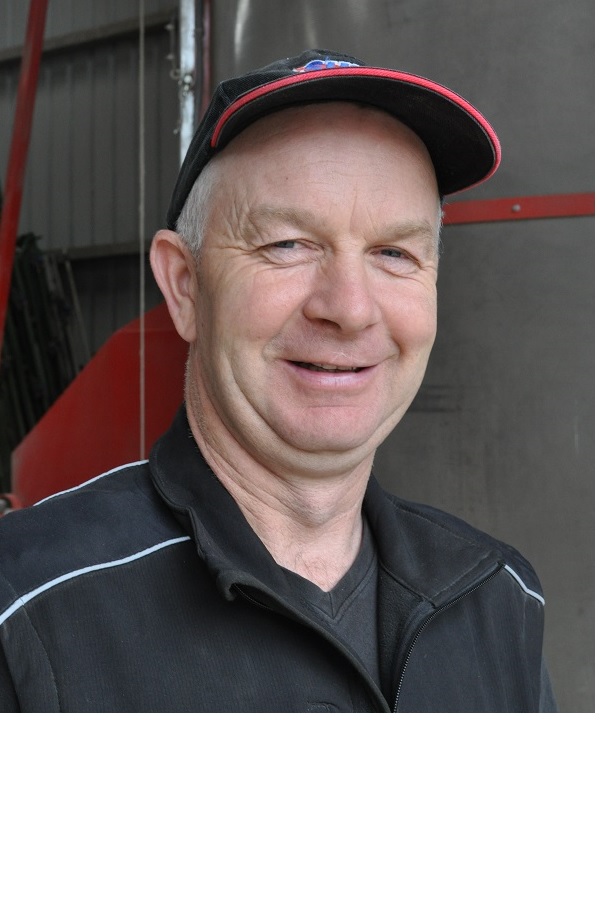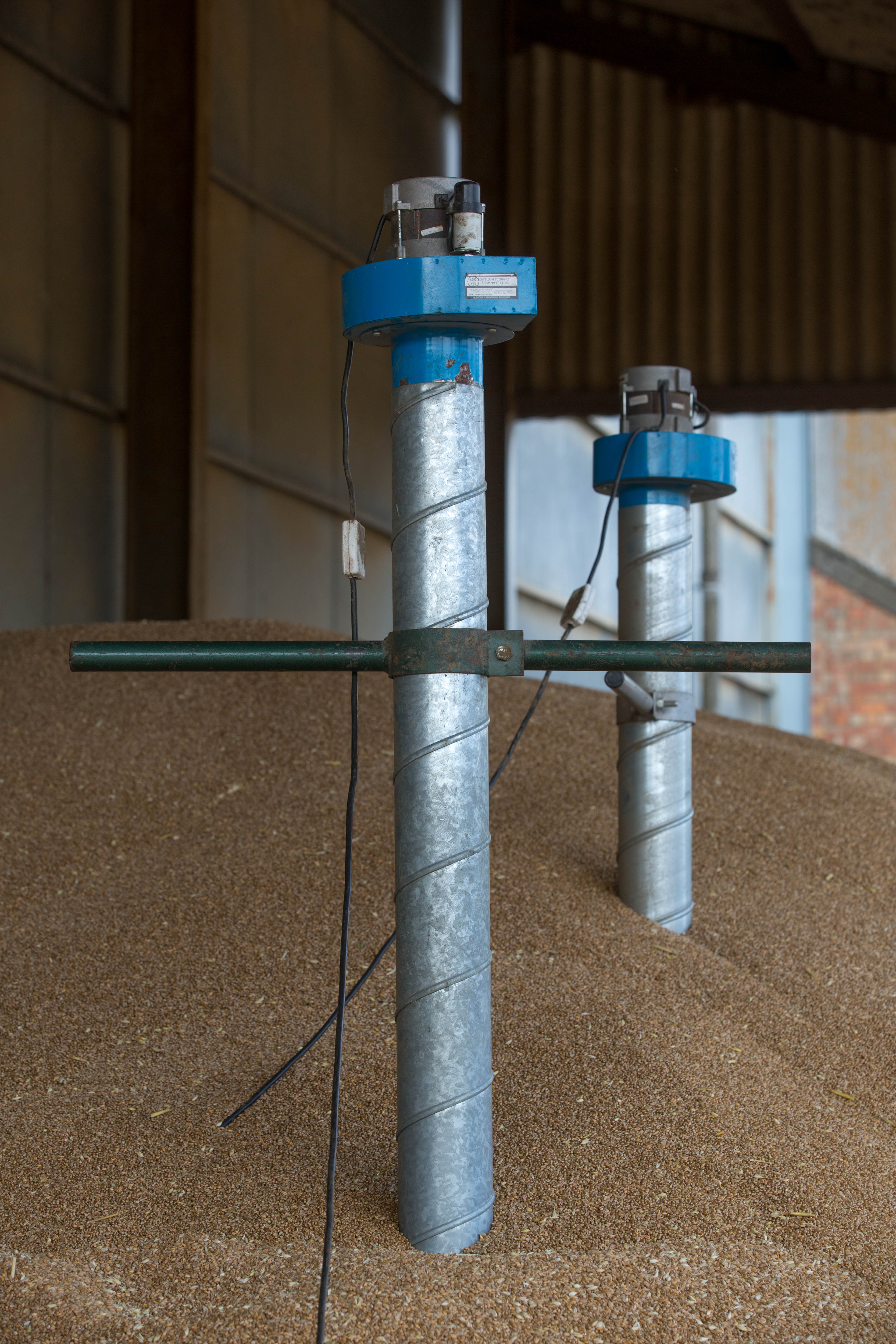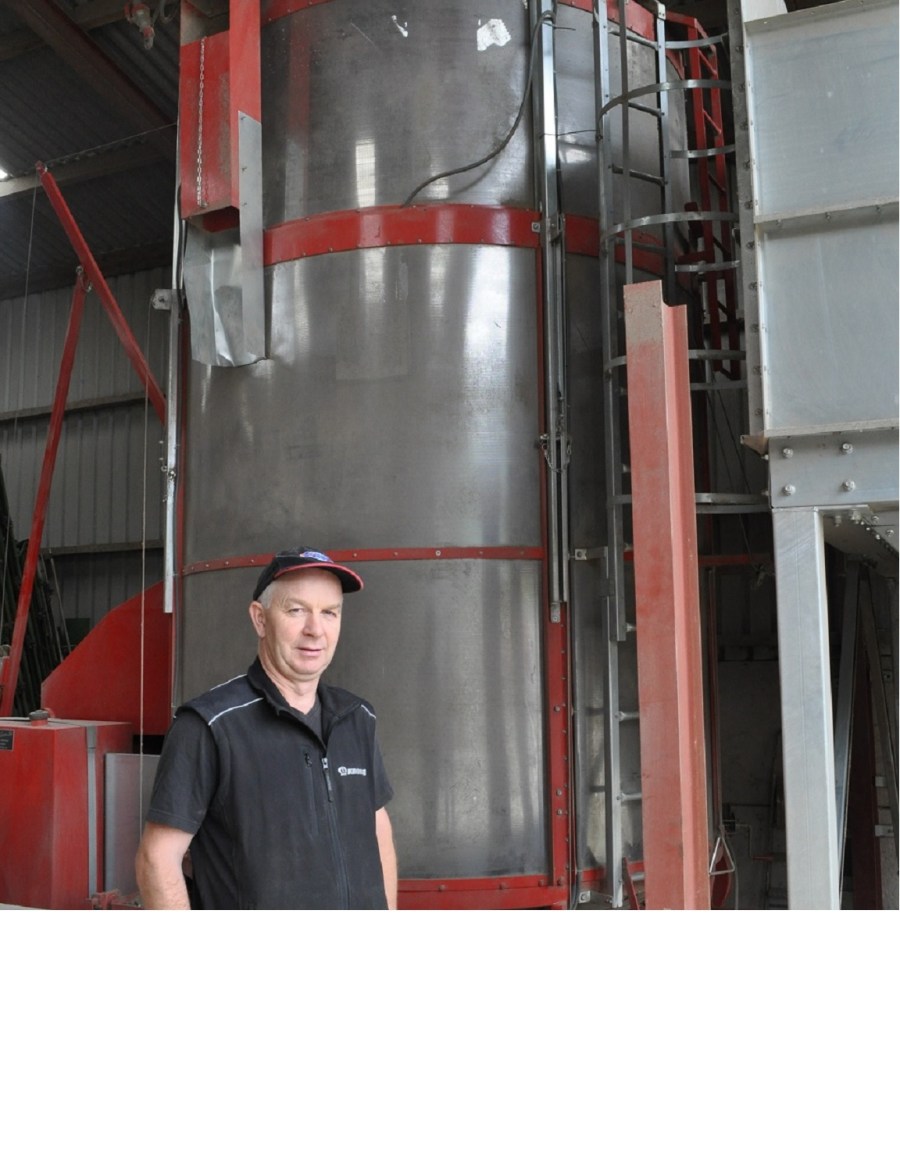Following an increase to their arable acreage, Yorks farmers John and David Thompson decided it was time to modernise their aged grain-drying set-up. CPM finds out how they got on.
The money we saved through not buying the larger one was enough to pay for everything else.
By Rob Jones
Increasing your grain-drying capacity isn’t always a case of buying a bigger dryer. Sometimes it’s about working out how to free up time and build in some automation to make a smaller drying system work more efficiently.
That was the case for John and David Thompson, cousins who farm in partnership with their fathers Les and Bill in North Yorks. They installed an electric-driven fully automatic 12t Magna grain dryer and a large holding bin into an existing shed. They can now dry 60t of grain each day and only have to load up twice.
At Green Farm near Pickering The family farms 200ha of arable land plus run sheep on 40ha of grassland, and buy in beef stores to finish. John Thompson’s son Brad has left college and is now working full time on the farm too.
“We expect to need to dry grain every year,” explains John Thompson. “In fact, we’ve only known one year – 1995 – when all the wheat came off at less than 16%.
Batch dryer
“For about 10 years, we’d had an old 12t Pedrotti mobile batch dryer, bought second hand at a farm sale. It was PTO-driven which tied up a tractor. It was also manual and so a lot of time was spent loading and unloading it. The heat for the drying came direct from the flame, and there were a couple of instances where the grain caught fire – so we couldn’t ever leave it.
“As the dryer got older, it needed to be ‘finely tuned’ to work well, and I didn’t like anyone else to touch the controls,” he adds.
The tipping point for a new drying set-up came when the Thompsons took on some more rented land and doubled the acreage of wheat that was grown. In upgrading their system, they were determined to get one that would be a good investment for the future, one that was as modern as possible and fully automatic so that it was less labour intensive.
They looked at all the mobile recirculating batch driers on the market, and decided to go with an Opico Magna diesel-fired dryer. They liked the design feature in which the burner heats up bricks (Duax core heat system) and then it’s the hot air, blown by a fan, which dries the grain. This safety feature also prevents unburnt fuel from getting into the grain.
“Good dealer back-up is also very important,” explains John Thompson. “We’d always had every confidence in our local dealer, Wilfred Scruton, for all our back of the tractor requirements. So we asked them for a grain dryer quote.”
The Thompsons asked for prices for two Magna Automatics – one with a 12t holding capacity, and one with a 20t. The drying throughputs (the time taken to reduce moisture by 5%) were 6t/hr and 10t/hr respectively.
“We needed a dryer set-up that could handle up to 800t of wheat grain coming in. So we were weighing up how long it would take to dry this.”
But they soon realised the priority wasn’t a faster throughput of grain wasn’t – it was having a dryer that was automated. “If drying gets behind then in this part of the country, there are usually wet days in the harvest season when we can catch up. We could dry up to 60t/day with the Pedrotti, but it was the manual operation that was the problem.”
Price difference
So on considering the price difference between the different sizes (around £13,000) the Thompsons decided on the 12t Magna – the same size as the old dryer.
The features of the Magna Automatic not only allow grain to be loaded and discharged automatically, but also include SMS text messaging. “If something goes wrong, the dryer shuts
itself down and sends a text message to three phones – mine, Brad’s and David’s. So someone can go back to the yard to sort the issue,” says John Thompson.
“The dryer is programmed using a touchscreen which is easy to understand and use. It’s just like a big mobile phone.”
They took the option of having a Sky-Vac dust-extraction system, and instead of using tractor power, a new 100 Amp electricity generator was purchased from local firm Yorkshire Generators. “It was only a couple of thousand pounds more than a similar second hand one, and of course, came

The main limitation with John Thompson’s old grain-drying set-up was that it had to be constantly supervised.
with a warranty.”
Each harvest time, the old dryer and a 3t holding bin would be temporarily sited in front of a shed built for storing round straw bales. But for the future, the Thompsons wanted the new dryer to be under cover so it could be used whatever the weather. So the straw was moved out into a brand new shed to make way for the dryer set-up.
However, siting the dryer inside the shed posed some challenges, as although it had been built to a height of four up-ended round bales, it was a tight squeeze for the dryer.
Fortunately, the gradient of the yard was such that there was a 60cm difference in ground height from one side of the shed to the other. So the solution was to create a split-level floor, and site the dryer in the lower area.
At the same time as concreting over the soil floor, raising it slightly to prevent water running in, concrete panels were installed along the walls, making the shed suitable for holding grain.
To be able to take full advantage of the automatic features of the dryer, a new 25t holding bin was purchased.
“With a 12t dryer and a 25t bin, then we go up at 7:00am, top up the diesel and then load enough grain for three loads to be dried. Then set it all off. The dryer heats and then cools the grain and an auger discharges it through to the next door shed. Then automatically the next 12t batch of grain is loaded. And so on.
“It depends how wet the grain is, but typically we expect a load to take two hours. So we can comfortably get 6 loads done, and only have to be back there once in the middle of the day to re-load the system.
“Having the dryer and bin on a lower level has been an accidental benefit: it gives the forklift driver a better view of how much grain is in the bin when he’s loading it.”
The new set-up was ready for the 2015 drying season. The farm averaged wheat yields of 10t/ha with most grain coming off the combine at 18% moisture. In all, the Magna clocked up 217 hours and dried 110 batches of cereals, beans and oilseed rape.
Further improvements
Not content with what is already a very tidy set-up, the Thompsons have plans for some further improvements. For this 2016 season, they’ve bought a 2t bucket for the forklift which will halve the time it takes to load the grain.
“We also want to lay concrete in front of both the sheds, so that there’s less mud brought into them, and the forklift can travel between them on clean ground,” says John Thompson.
“The generator – which spent the winter tucked under the holding bin, needs its own housing so that it can be positioned permanently. Then we can run some electrics from it and put lights in the sheds and also onto the yard.
“When we designed the pit for the dryer and the barriers around it, we left a doorway so it was easy to for anyone to quickly access the dryer’s control panel from inside the shed. But last season grain would sometimes back up beyond this point. So we need to add a door and raise the height of the barriers to stop grain falling down into the pit.
“It’s surprising how much muck and dust comes off the grain. So to save having to keep emptying the Sky Vac bags, I’m also thinking of building a box to collect the dust which can sit on a trailer, and then this can be taken away and dumped every few days. Another small improvement is to add some sheeting to prevent rain blowing into the holding bin.”
The Thompsons are pleased with their decision to install the Magna with the 12t holding capacity. “The money we saved through not buying the larger one was enough to pay for everything else: the new holding bin, the concrete panels in the drying shed and the concreting of the soil floor.”
However they’re also mindful of changes to crops and cropping areas in the future, which may force further upgrades to the drying system. “I’m not sure how much longer we’ll be growing OSR. It’s expensive to grow in the first place, and then there are the pigeons, slugs and cabbage stem flea beetle to contend with.
“If more ground becomes available for rent locally, then we’d like to increase our arable acreage. And with more grain that needs drying, we could simply sell the dryer and replace it with a 20t one. We wouldn’t need a bigger holding bin, and everything else is already there.”
Tech Specs: Magna 1200QF Automatic
- Drying capacity (21-16°C): 6t/hr
- Holding capacity: 12t (16m3)
- Weight (empty): 4200kg
- Width: 2.55m
- Working height (with SkyVac dust extractor): 6.2m
- Burner size (diesel/kerosene): 2,420,000 BTU/hr (600,000Kcal)
- Electric power used: 30kW (60Amp)
- Loading rate: 50t/hr (12min)
- Discharge time: 80t/hr (9min)
Keep it cool to maintain crop quality
Too many crops go into the store worth more than they are when they leave the farm, warns Rob White of crop storage specialists Evans and Pearce. “Inadequate or badly managed ventilation, or where crops aren’t ventilated at all, are the main reasons,” he advises.
While AHDB recommends an airflow of 6 cubic feet per minute (cfm) per stored tonne of crop, he says many farms ventilate as low as 1cfm per tonne, which runs the risk of storage spoilage and deductions from the buyer.
“Pedestal ventilation is incredibly successful in the UK. As a guide it will cost about £2/t per stored tonne of crop to purchase a pedestal system. Spend an extra £1-1.50/t and you’ll get a system that provides 150% more air, which will probably bring it more in line with AHDB recommendations,” he says.
Plan the store to ensure an even airflow, he advises. This starts with intended tonnage, to work out how many fans and pedestals are needed to move the air through the store without any areas that are under ventilated (see table below).
Having the correct ventilation capacity is not the only issue to consider, continues Rob White. “Try to ensure the air being drawn through the crop is always colder than the crop itself so the only

While AHDB recommends an airflow of 6 cubic feet per minute per stored tonne of crop, many farms ventilate as low as 1cfm per tonne, or not at all.
result can be cooling. It’s best for effective cooling that air temperatures are 4-6°C lower than that of the crop. A differential controller monitors storage temperature, compares it to ambient air temperature and then decides when the fans should be turned on and off.”
The best time of the day is usually 2-6am, so it’s best to use a system that operates automatically in your absence, but lets you monitor how much the fans have been running. “Fan control can be based on temperature with humidity an optional extra,” he adds. Wireless systems feed information back to a central controller so stores can be monitored remotely from either a pc or smart phone.
For the first 2-4 weeks after harvest, run the fans continually, he advises, as this allows the crop to stabilise as field heat is removed and keeps air channels open. “Low volume ventilation is all about heat removal not drying. Don’t worry about running the fans in damp conditions – if the air is cool enough to remove heat, turn them on. If fans aren’t run immediately after harvest because the ambient air is damp, this allows a crop time to heat up and air channels can close, preventing effective ventilation later on.”
| Moisture content of crop (Assumed temperature of 20°C) | Tonnes ventilated by VBW7 fan | Tonnes ventilated by VBW9 fan |
| 15% and below | 250 | 400 |
| 16-17% | 175 | 300 |
| 18% + | 100 | 200 |
Source: Evans and Pearce




